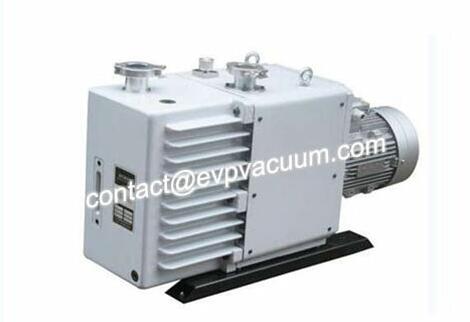Lab Vacuum Pump Selection
Laboratory vacuum pump is one of the most common laboratory equipment, and also one of the most difficult to choose. Vacuum pumps have many different designs and have a series of functions. It is very important to carefully consider the application of pumps before selecting a particular type.
When purchasing a laboratory vacuum pump, the first thing to do is whether a rotary vane (oil seal) pump is needed:
Rotary vane pump is a traditional vacuum pump, which is still widely used. However, they are only needed in applications requiring a larger vacuum.
Rotary vane pump
Rotary vane pumps can only be used in high-demand evaporation, filtration and drying processes that diaphragm pumps cannot support.(
A. Ultimate Vacuum: 1-10-3 MB Vacuum
This vacuum is applicable to:
freeze drying
Rotating vane pumps may also be required to evaporate high boiling solvents at or below room temperature. Rotary vane pumps are often used for rotary evaporation and concentrator to cause collisions. For high-flow applications such as suction and filtration, rotating vane pumps will generate high-load oil mist.
flow
Rotary vane pumps are usually used in applications that depend more on the limit vacuum than on the flow rate. However, large freeze dryers or large Schlenk manifolds may require larger pumps.
Vacuum monitoring and control
Instruments help ensure system sealing and provide the fine vacuum required for these applications.
Manual control: Manual control is typical, but not suitable for many rotary blade applications. The use of relief valves (controlled leaks) to regulate vacuum pressure usually results in high-load oil mist that must be controlled.
Two-point control: When using rotary vane pump to evaporate solvent with high boiling point, it may be helpful to use solenoid valve to control vacuum.
Uncontrollable: For some applications, vacuum control is considered unnecessary and pumps only need to operate at full load.
Dry scroll pump: It is an excellent substitute for rotary vane pump without oil pumping. The technology is suitable for non-corrosive liquids and can provide low limit pressure at high speed. Dry scroll pump is oil-free, durable, reliable and easy to maintain.
Definition
1. Extreme vacuum
The final vacuum specification of the pump describes the minimum pressure that the pump can achieve – that is, the pressure that can no longer move any steam. Choose pumps with the ultimate vacuum specification, which is lower than the pressure you plan to operate. For example, if you need to run the application under 10 Torr, do not select 10 Torr pump.
2. Flow
The flow rate is the volume of gas that the pump can move per unit time. Regardless of the vacuum required, larger applications require higher flow pumps. The flow rate (also known as pumping speed or free air displacement) in the specifications of vacuum pumps refers to the maximum speed at which the pump can move steam at atmospheric pressure (i.e. without vacuum). When you run at the required vacuum level, the actual pumping speed of a pump with the same flow specification may vary considerably (if the pump does not generate enough flow at the required vacuum level, the application will proceed more slowly or, in extreme cases, not at all). The flow curve shows the proportion of the specified flow rate available in the vacuum range provided by the pump. Buyer should ask Pump’
Control options
Manual control: Simple on/off control, or manual flow control with pinch valves or exhaust valves. This provides a very approximate control of vacuum by manually matching the pumping speed with the steam flow rate, which varies with the vacuum pressure. Instruments should be used to monitor vacuum pressure conditions to guide manual operation.
Electronic two-point control: control vacuum as a thermostat to control temperature. The target pressure is set, and the electronic controller keeps the applied pressure in a narrow range near the target by opening and closing the pump or by opening and closing the solenoid valve to allow or limit the pumping of the application. Usually you can program settings and slopes.
Electronic adaptive control: This is the highest level of control. Depending on the instantaneous detection of application conditions, the motor speed varies continuously to provide the pumping speed needed to maintain the target pressure and reduce the risk of over pumping (collision). It is very useful for protecting key samples and fully automated evaporation applications.
3. Unit Conversion
Many different units of measurement are used to describe vacuum pressure. The most common are millibars (mbar) and tolls (millimeter mercury column). These are absolute pressure measurements starting at 0 at standard atmospheric pressure and in the range of 1000 millibars or 760 torres. For two reasons, these measurements of vacuum pressure are better than the gauge pressure calculated from atmospheric pressure. First, atmospheric pressure varies from place to place, so using atmospheric pressure as a basis is not a reliable measure. Secondly, the mbar and Torr gauges generate simple numbers under working vacuum pressure in the laboratory (e.g. 20 or 15 Torr), while the gauge pressure measured with an inch mercury column reaches 29 inches at about 30 mbar, and then the common vacuum conditions in the laboratory must be described by measuring three or four decimal places.
More vacuum is not always better! By matching your vacuum pump with the vacuum required for your application, you will achieve higher productivity, reduce the risk of over pumping samples, reduce service demand and reduce noise.
For performance, convenience and service, do not use oil pump when oil-free diaphragm pump can complete its work.
If you plan to pass corrosive steam through the pump, please purchase a pump specially designed for corrosive steam. Your pump will serve you for a long time.


